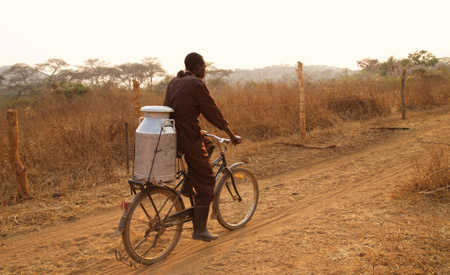Beene, a 16-year-old girl Zambian girl, wanted nothing more than to go to school.
But there was one problem: As in much of rural Africa, public transportation was non-existent, which meant she had to walk five miles one way. The effort was taking a toll on her body. In particular, she had developed severe pain in her legs that made the journey nearly impossible. That meant staying home more often than not, which meant missing out on a vital education. She would have given anything for a school bus.
In 2011 she got something that was arguably even better: a sturdy new bike from World Bicycle Relief, a Chicago-based organization dedicated to delivering bikes free of charge to needy people in developing countries. This simple, low-tech form of transportation changed Beene’s life. For the first time, she could attend classes five days a week. She even had energy left over to play sports, do her homework, care for her nieces and nephews, and help out with household chores. Her dreams of becoming a nurse, which once seemed so distant, are now closer to reality than ever. And when she’s not riding to school, others in her family use the bike to transport fish to sell in surrounding villages or take children to a clinic eight miles away.
Around the world, from Washington D.C. to European capitals to rural Africa, the humble bicycle is having a moment. Slowly, quietly, it is transforming how people exercise, commute, shop, and recreate. By taking a leisurely ride on back streets that once were only a blur through the tempered glass of motorized steel cocoons, cyclists are getting to know their local communities more intimately, and their cardiovascular systems are thanking them. So are local businesses, because bikers are more likely than drivers to stop and buy a latte or some other impulse item. Because of these and myriad other benefits of cycling, municipalities big and small are trying to make their communities more bike-friendly. At the same time, visions of two-wheeled utopias are, in many cases, running ahead of less-than-optimal facts on the ground.
Take World Bicycle Relief. Founded in the aftermath of the Indian Ocean tsunami, the group seeks to provide cheap transportation in places where roads are nothing but a pipe dream. Its bikes are built to spec in Asia and assembled in Africa by trained local staff. Last year the group delivered more than 47,000 of them to recipients in 13 countries across Africa and Southeast Asia, up from about 29,000 in 2012 and 6,000 in 2005.
“The bicycle turns out to be a particularly good way to get around where there aren’t other options,” says Charles Coustan, the group’s executive director and a Maryland native. For example, when the tsunami destroyed every scrap of infrastructure, World Bicycle Relief bikes—steel-framed and rugged, designed to take the worst that decimated roads can dish out, and fitted with components that can be replaced locally—helped families reconnect, get to medical clinics, and eventually move back into their homes. “The number of places and ways that bicycles can provide basic transportation has been amazing,” he says.
One of the things bikes do best in developing countries is facilitate school attendance. For example, a recent study showed a 28 percent increase in Zambian girls’ attendance rates and a 50 percent increase in academic performance after they received bikes from World Bicycle Relief. “In places where there’s no electricity and running water, the amount of daylight dictates the amount of work you can get done during the day,” Coustan points out. “If it takes two hours to walk to school but only half an hour to bike, that hour-and-a-half savings each way has a dramatic impact.” Factor in easier, faster access to medical care and better economic opportunities, and it’s hard to imagine a less costly, more effective way to improve the lives of tens of thousands of people.
Of course, while distributing 47,000 bikes is quite an accomplishment, it’s a pittance compared to the millions of people around the world who need one. Although World Bicycle Relief is looking to impact more countries, the challenges can be nearly intractable: supply chains, transportation issues, regulatory red tape. But Coustan remains staunchly upbeat. “Our growth has been strong, the bikes have been very well received, and we’ve built strong partnerships with NGOs on the ground,” he says. “We’re very optimistic that the bikes will continue to have an impact as good, basic, reliable transportation.”
Not only are bikes transforming lives in developing nations, but they’re also starting to have a remarkable—if somewhat different—impact in the United States and other industrialized countries. In particular, they have the potential to free us, at least in part, from the tyranny of the automobile. Ask any working adult what he or she hates most about life, and commuting will probably top the list, or nearly so. Sitting in traffic is not just a mind-numbing chore that alternately prompts fits of rage and “what the heck am I doing with my life” angst; it also imposes a staggering cost in terms of lost fuel and productivity. One 2007 study found that U.S. traffic jams wasted $87.2 billion, 2.8 billion gallons of gas, and 4.2 billion hours. That’s about $750, three weeks’ worth of fuel, and almost a full work week for every U.S. traveler. Thought you got two weeks of vacation every year? Turns out you only get one.
Enter bike commuting, a trend that’s sweeping urban areas around the country and appears to have jumped from the fad stage to something that could inspire a true paradigm shift not just in how we get to work, but in how we play. To date, more than 40 municipalities have implemented some kind of bike sharing program, and just about every decent-sized urban area that doesn’t have one is thinking hard about it.
A prime example is the Washington D.C. area’s Capital Bikeshare program. When it started in 2008, it became the first program of its kind in North America and currently is the nation’s second-largest after New York City’s. Owned jointly by the District, Montgomery County, Arlington County, and the city of Alexandria, it offers more than 2,500 bikes at more than 300 stations. Simply walk up to a station and rent a bike for 24 hours for $7, or (by far the more popular option) pay a $75 annual membership fee and use one anytime you want.
Chris Eatough, program manager for Bike Arlington, a Capital Bikeshare partner, says bike sharing is integral to a broader transportation strategy that city planners hope will coax people out of their cars. “This is just part of a growing movement, especially for urban areas, to incorporate more transportation options other than driving everywhere,” he says. “Buses, light rail, and car sharing are part of that, but also a lot of cities are trying to get more people on bikes because it’s convenient, cheap, and fun.”
Cheap is relative, of course. More cyclists means building more bike lanes and trails, which in turn requires a rethink of typical car-centric urban planning. And then there’s the infrastructure needed for the program itself; the tab for each Capital Bikeshare bike comes to about $1,200, and each solar-powered, internet-connected station costs between $30,000 and $50,000. The local government sponsors also have to outsource maintenance, membership services, bike transport, and the like. The total system cost comes to about $10 million. That might seem steep, but it’s far less expensive and requires much less lead time than, say, building a light rail system or adding dedicated express bus lanes to existing roads.
Not only is the program relatively easy on municipal coffers, but it seems to be working as an alternative mode of urban transport. According to Eatough, surveys show that 13 percent of the approximately 6 million trips taken with Capital Bikeshare bikes since the program’s inception have replaced trips by automobile. That amounts to about 780,000 fewer cars clogging the streets, with a proportionate reduction in parking requirements and carbon dioxide emissions. By any reasonable measure, the investment should be a no-brainer for other cities looking to follow D.C.’s example. “It’s transforming the way people get around,” Eatough says. “It’s also a way to lower the cost of getting started in the sport because you don’t have to buy, maintain, and store a bike. The program is going a long way toward making cycling much more normal, something everyone can do.”
Bike sharing also fits nicely into the country’s accelerating urbanization trend. “People don’t necessarily want to live in the suburbs and drive into their jobs—they want to live in the cities where things are happening,” Eatough says. “The end goal is not to get everyone on a bike share bike, but to offer really robust transportation options that don’t involve a car. It’s about making our cities nicer places to be.”
Dani Simons, director of marketing for New York City Bikeshare, is equally enthusiastic. That program started just last year with 6,000 bikes and 330 stations, and already it boasts 98,000 annual members that have collectively ridden more than one million miles. For New York, it’s not so much about getting people to drive less, because relatively few city residents have cars. Rather, it’s about improving public health and connecting neighborhoods that previously had no public transportation links. “Bike sharing is just a great, sustainable transportation option,” she says. “We have the density that’s needed to really make the program a success.”
Of course, no bike sharing program will work unless lots of people find a reason to start riding. For Annapolis, Md. resident Lili Afkhami, motivation took the form of a pizza. Sitting in her college dorm room back in 2006, Afkhami—who weighed 270 pounds at the time—decided to order up some Dominos. The cheese-drench disk of deliciousness finally arrived in its aromatic cardboard box, and she swore she’d only have part of it and save the rest for tomorrow. Next thing she knew, the whole pie was gone. “It was an ‘aha’ moment for me,” she says. “I realized this was not the life I wanted to live.”
But how to escape the trap of overeating, deteriorating health, no exercise, and more overeating? For Afkhami, that vicious cycle was finally defeated by, among other things, cycling. She discovered a passion for a sport that helped her lose 100 pounds and led to an interest in other physical activities that reinforced her health gains.
“When I first started going to the gym, I couldn’t do anything for more than five minutes at a time, but I kept going back because I realized I didn’t want to live that sedentary lifestyle,” she says. “Cycling really changed my entire outlook on life. When you’re unhealthy and overweight, you really miss out on a lot, but you don’t realize how much until you’re healthy.”
How healthy? These days you’ll find Afkhami biking 50-75 miles on a weekend, along with swimming, running, and competing in triathlons on a regular basis. She also just bought a folding bike for her 10-mile commute.
“Cycling has been just one part of my journey to fitness,” she says. “A weekend for me used to be simply lounging around. Now I have so many more opportunities to experience life and be around people who are like-minded and active. It’s about doing small things that add up to big life changes.”
Afkhami is the development officer for the League of American Bicyclists, a Washington-based group that lobbies for bike-friendly legislation (see sidebar) and works with communities, universities, and businesses. Among other things, the group helps cities decide where to build bike lanes, certifies cycling instructors who teach around the country, and helps companies implement policies that encourage bike commuting. The League also participated in the National Bike Summit in March, where more than 700 people met to discuss best practices and hobnob with members of Congress.
Communications Director Carolyn Szczepanski said legislators have embraced, at least rhetorically, the message that biking is a relatively cheap, easy path to urban renewal. “It enhances the quality of life in a community when you have people out talking to each other and smiling at each other,” she says. “When you’re exclusively car-centric, that vibrancy isn’t there.” She also noted that lots of city streets in the U.S. could stand to go on a “road diet”, i.e. reduce excess lane width to accommodate bike lanes with minimal disruption to traffic flow and surrounding buildings. The resulting economic benefits of such measures can dwarf the costs. For example, one recent study conducted by Advocacy Advance, a partnership of the League of American Bicyclists and the Alliance for Biking & Walking, found that the nation’s 60 million annual recreational bicyclists spend nearly $47 billion on meals, transportation, lodging, gifts, and entertainment. The economic ripple effects of all biking-related activities could be as large as $133 billion, supporting 1.1 million jobs and generating $17.7 billion in federal, state, and local taxes.
Add to all this the much lower costs of owning and operating a bike compared to a car, along with the obvious health benefits of peddling over driving, and you might wonder why it’s taken so long for us as a nation to jump in the saddle. The answer is complicated, but it surely includes the usual suspects: inertia, laziness, and political gridlock. People are set in their ways, and driving is a hard habit to break—especially when alternatives involve physical effort. As for Congress, partisan bickering has reached such heights of absurdity that a resolution declaring kittens to be adorable might get only 49 votes in the Senate. But Szczepanski rightly points to signs of progress as well, including the fact that one in five Americans now lives in a bike-friendly town. “Larger cities understand that the millennial generation is driving less and looking for more bikeable and walkable communities,” she says. “The bikeshare movement has been absolutely transformative, and people are really starting to see biking as a transportation option. Americans recognize that we have an epidemic of obesity and sedentary diseases, and a lot of people are taking action. Biking is such a great way to take care of so many of these problems, and it’s accessible to all ages.”








